Doves may be relatively common, usually their colours are subtle, but they should not be taken for granted. The understated beauty of doves is something to be celebrated.
I think that doves are particularly charming and I have posted about them before. That a species is common does not guarantee its survival in the face of onslaughts that might include persecution, unsustainable hunting, habitat loss, and the effects of pesticides and other toxic substances and pollutants. The extinction in the late 1800s of the common Passenger Pigeon in North America is a particularly dramatic example of the complete eradication of a numerous population of birds (for more on the Passenger Pigeon see here).
There are four species of dove that visit our garden – two are considered common and two less so. Our garden is also visited by a fifth member of the Columbidae family (which comprises doves and pigeons), namely, the African Olive Pigeon, but in this post I will stick to the species termed as being doves, at least in the English language.
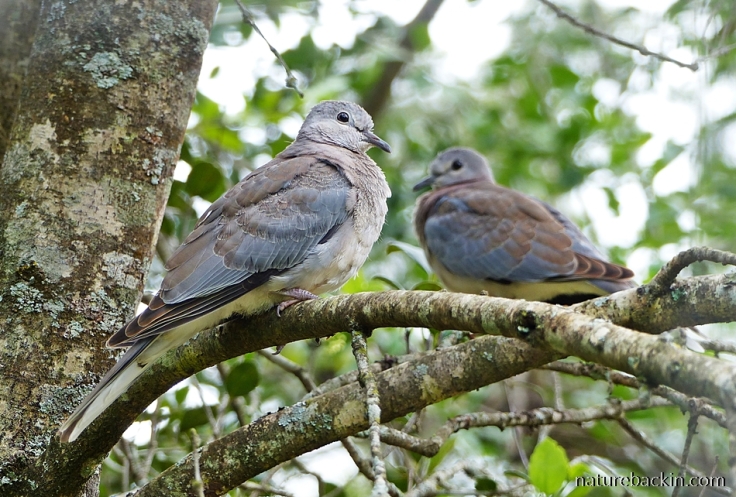
Recently fledged Laughing Doves in the garden
Laughing Doves (Spilopelia senegalensis) are a modest presence in our garden. They are relatively small doves and they spend a lot of their time foraging on the ground. For more about Laughing Doves see here and here.

The Red-eyed Dove is much larger than the Laughing Dove and is a more powerful presence
The Red-eyed Dove (Streptopelia semitorquata) graces our neighbourhood with its lovely lilting call. It is similar to the Ring-necked Dove (Streptopelia capicola) that also occurs in our region but does not visit our neighbourhood. For more about these doves see here.
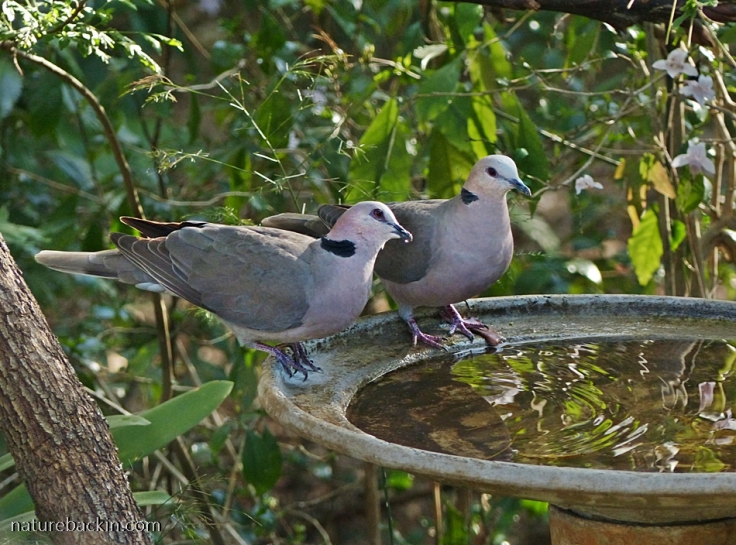
A pair of Red-eyed Doves sharing a late afternoon drink at a garden birdbath
When we first moved to where we now live about 15 years ago a small posse of Tambourine Doves (Turtur tympanistria) used to visit regularly foraging together as a group. Sadly, these days we only see one or two doves at a time and not as frequently as before, and their wonderful liquid call is less apparent too.
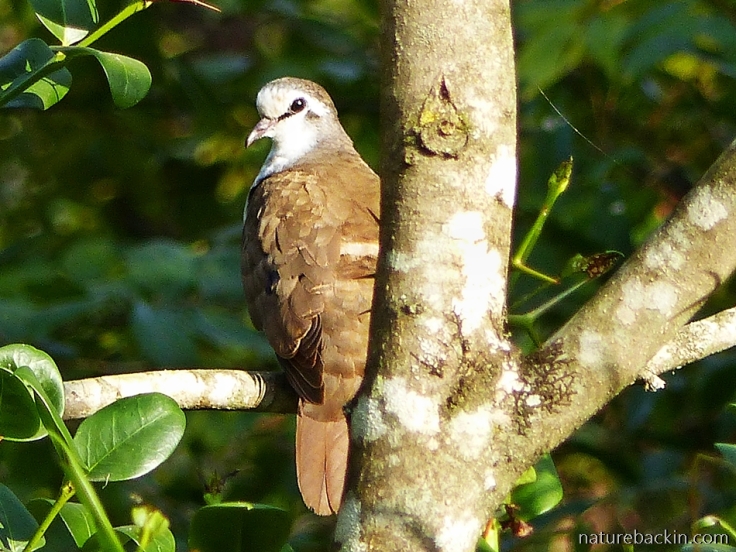
Very shy, I had to photograph this Tambourine Dove from afar and hence a rather grainy pic
Tambourine Doves are striking because of their unexpectedly bright white underside. Also noticeable are the iridescent emerald green spots on their wings. When they fly their chestnut-coloured wing feathers are very evident.

Also photographed from afar and through a window, this Tambourine Dove is foraging in its typical almost crouching posture
The fourth dove to visit our garden is the Lemon Dove (Columba larvata), which featured previously in this post. It usually sticks to thick cover and I have only seen it venturing out onto more open ground at dusk or on very overcast days (when the low light adds to the difficult of photographing this usually wary bird). Recently though, when there were a few overcast days we were delighted to see a pair of Lemon Doves venturing out to look for seed on a patch of lawn.

A pair of Lemon Doves shyly seeking fallen seed on an overcast day
Celebrating “ordinary” doves has made me mindful once again of Joni Mitchell’s song “Big Yellow Taxi”. She wrote this song on a visit to Hawaii in 1970 and it remains just as pertinent today – if not more so.
This is the first verse:
They paved paradise
And put up a parking lot
With a pink hotel, a boutique
And a swinging hot spot
Don’t it always seem to go
That you don’t know what you’ve got
‘Till it’s gone
They paved paradise
And put up a parking lot
And here is a clip of the incomparable Joni Mitchell performing “Big Yellow Taxi” back in 1970.
And demonstrating that there is no room for complacency regarding the survival of even common birds, a recent study published in the journal Science found that nearly 30% of the total number of birds, including even common birds such as sparrows and blackbirds, are in decline in the United States and Canada, and these declines are occurring across all biomes (see here for further details about this study).
There has, however, been a recovery in numbers of some birds species associated with wetlands due to a proactive protection of wetlands, and some raptors such as Bald Eagles have increased in number because of increased protection and the banning of DDT (see here).
Among factors contributing to declining bird numbers are habitat loss, seashore developments, industrial-scale intensive agriculture, the widespread use of pesticides and climate change. Improved conservation of habitat and increasing and enforcing regulations to protect birds are sorely needed, but at the same time we can all contribute to the well-being of birds.
Backyard gardeners can play an especially important role in providing for birds (and for the critters that are sources of food for insectivorous and predatory birds) by planting native plants, reducing lawn by planting more shrubs and trees, and by not using pesticides or rodenticides (for recent information on how rodenticides kill non-target species of birds and mammals (including caracals and mountain lions) see https://www.humanegardener.com/rodenticides-modern-day-ddt/).
Other practices to help protect birds include trying to make windows safer to cut down on bird strikes, advocating for bans on single-use plastic items and avoiding using disposable plastic (and other) items as much as possible. Owners of pet cats can provide their cats with enclosed gardens or catios to prevent cats from roaming and hunting (and it makes cats safer too).
For more information and tips on how to be more bird-friendly see: Seven simple actions to help birds.
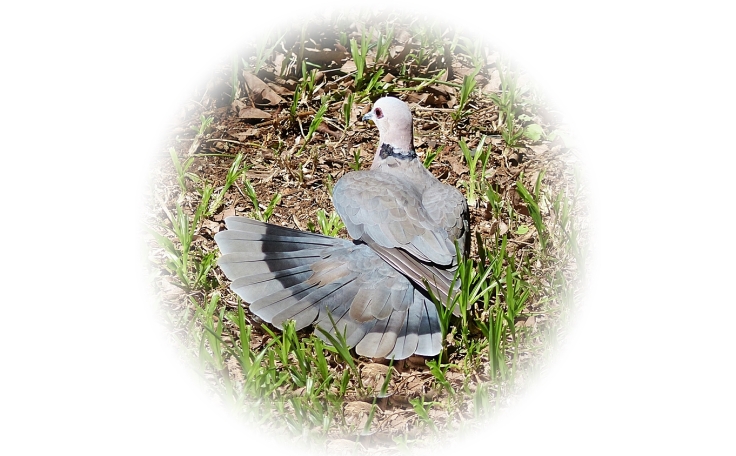
Sources: Daley, Jim. 2019. Silent Skies: Billions of North American Birds Have Vanished. 10 September. Scientific American. https://www.scientificamerican.com/article/silent-skies-billions-of-north-american-birds-have-vanished/; Penisi, Elizabeth. 2019. Three billion North American birds have vanished since 1970, surveys show. Science, 19 September. https://www.sciencemag.org/news/2019/09/three-billion-north-american-birds-have-vanished-1970-surveys-show; Cornell University. 2018.Seven Simple Actions to Help Birds. https://www.birds.cornell.edu/home/seven-simple-actions-to-help-birds/
P.S. I will be away on a road trip to the Western Cape for two weeks and I have scheduled the next two posts to be published automatically during my absence.
Posted by Carol






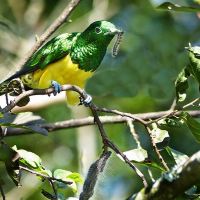
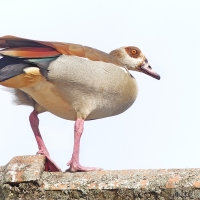

December 17, 2019 at 11:48 pm
What a wonderful blog for biodiversity and we both use the nature and nurture idea. So crucial now to look after our natural world. You have an incredible variety of doves.
LikeLiked by 1 person
December 18, 2019 at 12:14 pm
Thanks very much and a lovely coincidence that we both use the nature and nurture idea :). Nice to connect!
We are blessed with a variety of doves – there are even more in South Africa surprisingly – I limited the post to those regularly visiting our garden.
LikeLiked by 1 person
December 18, 2019 at 1:45 pm
Some beautiful ones, the love doves look rather like the European turtle dove.
LikeLike
October 27, 2019 at 3:25 am
A fun post for one who only knows of one dove species around here. So many birds are far more colorful when seen in the right light. Looks like your doves also have subtle colors that show up when the sun cooperates.
Funny about the Joni Mitchell song. We was a neighbor a good distance from our house who bought a lovely little plot with some fruit trees on it. They tore out all the orchard and put in a HUGE pole barn and a house. The final outrage was paving (with cement) the little that remained of any uncovered ground. I actually wanted to get some sidewalk chalk and quote Joni’s lines:
They paved paradise
And put up a parking lot
LikeLiked by 1 person
November 7, 2019 at 7:50 pm
Thanks Gunta.
That story about your neighbour is awfully depressing. I wonder why folks who want buildings and paving don’t just stay in the city which is already paved?
LikeLike
November 15, 2019 at 11:54 pm
I’ve often wondered the same. There is just something so very, very wrong about paving every strip of ground like that. And to mow down those wonderful fruit trees. I almost cried.
LikeLiked by 1 person
November 19, 2019 at 12:54 pm
I completely understand how upsetting that is.
LikeLike
October 19, 2019 at 11:55 pm
Seems like the decline of many species, rare and common, has much to do with the continuing rise in the number of humans. One would like to think we can learn about actions we can take to make things better, but events in this country and elsewhere don’t seem to indicate much capacity for learning. Perhaps nature, as it does in many cases where imbalance exists, will take care of matters.
Enjoy your road trip. I look forward to seeing photos from it.
LikeLiked by 1 person
November 7, 2019 at 7:34 pm
Thanks for the good wishes.
LikeLiked by 1 person
October 19, 2019 at 7:01 am
Lovely! Thank you Carol – I did not know we had so many types of doves. Sobering to think that even our common birds are potentially vulnerable..
LikeLiked by 1 person
November 7, 2019 at 7:34 pm
Indeed it is sobering.
LikeLike
October 19, 2019 at 6:05 am
I was just reading about the seven things what we can do to help birds. I will look if I can find in Germany a birdfriendly coffee… Have a nice weekend!
LikeLiked by 1 person
November 7, 2019 at 7:33 pm
It might be worth investigating some of the Ethiopian coffees. Thanks for the good wishes.
LikeLiked by 1 person
October 18, 2019 at 3:33 pm
Amazing variety of doves, as Margaret has already said! 30% decrease is too much! Each of us can do something to prevent that! Thanks for sharing the links, Carol!
LikeLiked by 1 person
October 18, 2019 at 9:14 pm
Yes the decline in bird numbers is sobering. If only more mixed methods of farming could be reintroduced rather than the continuing spread of intensive monoculture farming. But yes those of us who have some space can choose to use it to benefit birds and other forms of life.
LikeLiked by 1 person
October 18, 2019 at 12:27 pm
I do love the doves. We have rock doves and of course, pigeons here. Enjoy your road trip, Carol 🙂
LikeLiked by 1 person
October 18, 2019 at 9:10 pm
Thanks for you good wishes for our trip Sandra.
LikeLiked by 1 person
October 18, 2019 at 8:17 am
After reading your informative post I went into our garden to confirm that the doves who inhabit it are red eyes. And of course I could not find a single dove! Thanks for another beautifully written, photographed and researched article. The information on the environmental threats to birds is frightening. A friend who visit Japan said that she noticed the absence of birdsong in the cities. We who have gardens filled with birdsong are lucky.
PS Earlier this week there were two hornbills sitting and wailing loudly at one another in the topmost branches of the jacaranda tree in the garden. It was both funny and remarkable.
LikeLike
October 18, 2019 at 9:09 pm
Yes those of us who are fortunate enough to live with birdsong don’t always appreciate how lucky we are.
How wonderful to have visiting hornbills!
LikeLiked by 1 person
October 18, 2019 at 6:48 am
Too good information on these lovely birds, Carol. Never knew so much about them. Thanks so much for your awesome share.
LikeLiked by 1 person
October 18, 2019 at 9:22 pm
Thanks so much Kamal. Glad to know that you also appreciate the loveliness of doves.
LikeLike
October 19, 2019 at 4:01 am
Welcome 😊😊 😊 and yes why not.
LikeLiked by 1 person
October 18, 2019 at 5:52 am
I’m impressed by the rich variety of doves that you have. We too have several, though none as ubiquitous as the omnipresent woodpigeon ( I assume a pigeon is a type of dove?). They seem to have more interesting calls too. The continuing decline of some is concerning though. Nevertheless, have a wonderful road trip. I hope we’ll hear all about it on your return!
LikeLiked by 2 people
October 18, 2019 at 9:06 pm
There doesn’t seem to be any meaningful or consistent distinctions between pigeons and doves.
Thanks for your good wishes for our trip and I expect that there will photos to share after we get back 🙂
LikeLiked by 1 person
October 20, 2019 at 8:08 am
I hope so! Enjoy!
LikeLiked by 1 person
November 7, 2019 at 7:36 pm
Thanks!
LikeLiked by 1 person
October 18, 2019 at 4:28 am
Serendipitous or what – I recently posted about doves too! I have only noted a Lemon Dove once in our garden, and that was years ago. We have Laughing Doves aplenty as well as Red-eyed Doves and Cape Turtle Doves – the latter tend to keep more to themselves. Domestic cats in a neighbourhood can be a problem for anyone interested in attracting birds to their garden, nonetheless the provision of food, shelter and water for birds is essential if they are to survive in the urban areas.
LikeLiked by 1 person
October 18, 2019 at 9:04 pm
I enjoyed your post on doves Anne. Your garden seems to be a wonderful haven for birds.
LikeLike
October 18, 2019 at 2:43 am
First off, enjoy your trip to the Cape, Carol, and bring back lots of photos please!?
What would be the distinction between pigeons and doves – I don’t think it is size as some doves are really big and others are rather small in comparison. In Afrikaans they’re all “duiwe”.
We have a tiny garden at out townhouse, and have decided to give the whole plot over to indigenous shrubs – of which we now have 10+ kinds. I can’t wait to see the butterflies lining up!
LikeLiked by 1 person
October 18, 2019 at 8:29 pm
Thanks for the good wishes for our trip. And yes, I am taking my camera 🙂
The dove/pigeon distinction seems to be peculiar to the English language although there is a notion that doves are generally smaller even though that is not consistently the case as you say.
How great to devote your space to indigenous shrubs – they are likely to attract many delightful visitors and serve as some kind of solace when you are pining to be out in the bush.
LikeLiked by 1 person
October 19, 2019 at 2:06 am
Our thoughst exactly. Our latest addition is a Lowveld Bitter Tea – after seeing the masses of butterflies and other insects they attracted in autumn in Kruger I just had to have one!
LikeLiked by 1 person
October 18, 2019 at 12:00 am
Too sad, I hope the press that study is getting will motivate people to action.
LikeLiked by 1 person
October 18, 2019 at 8:20 pm
Let’s hope so. Good that the study is getting attention.
LikeLike